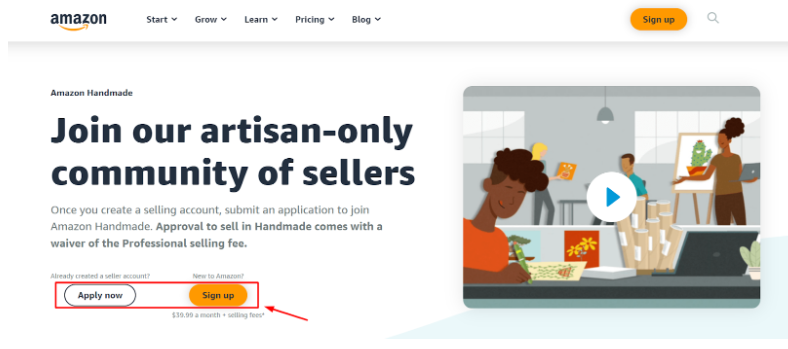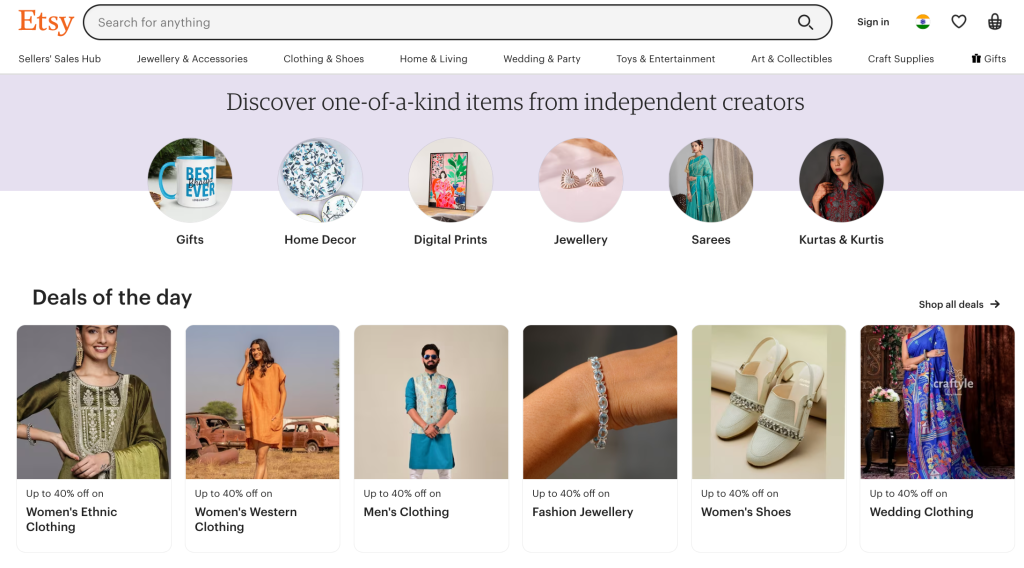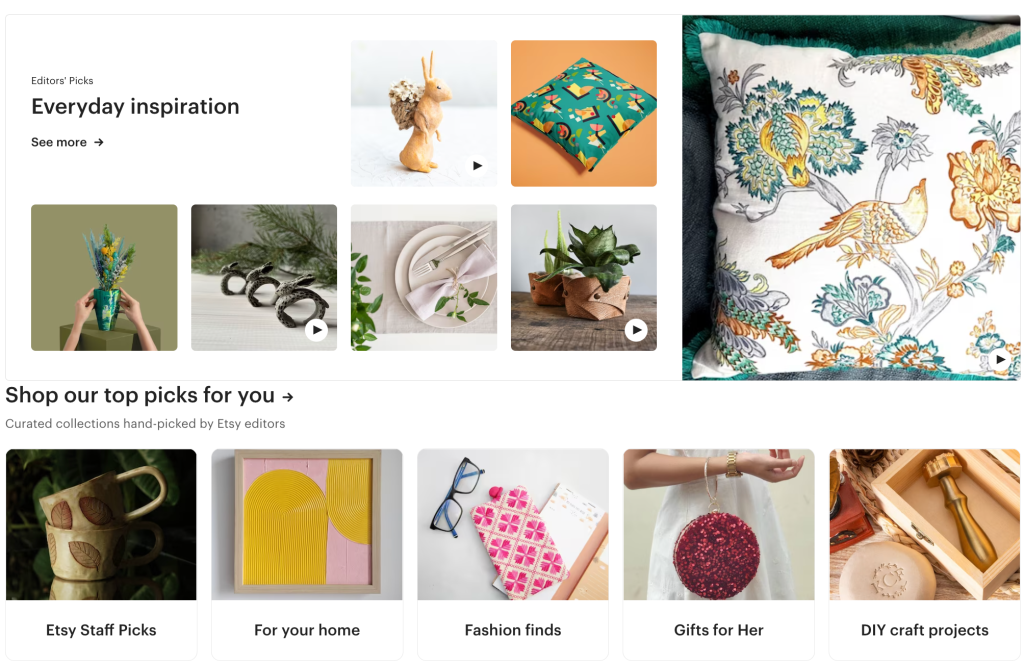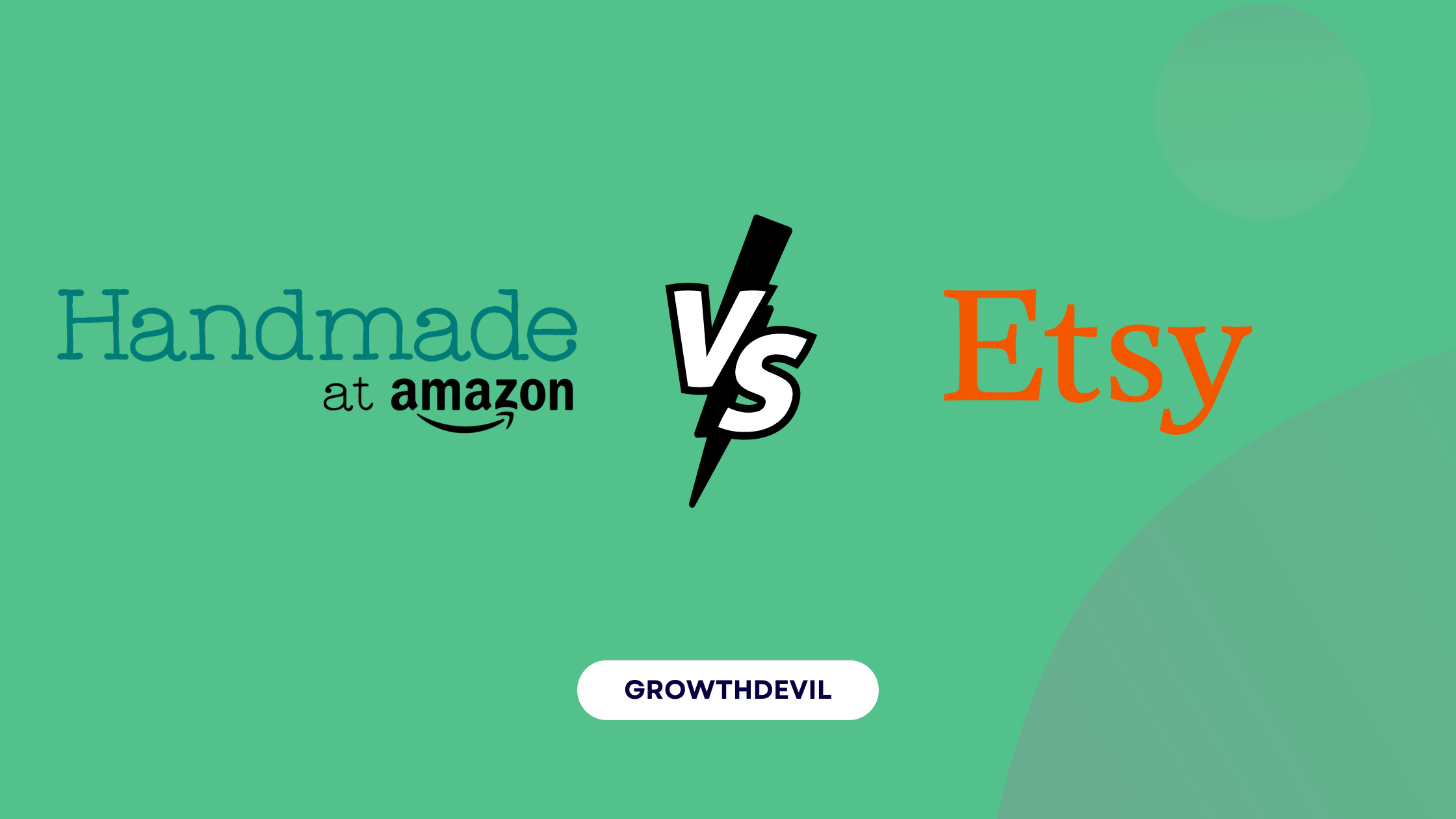Amazon Handmade and Etsy have emerged as two major online marketplaces for artisans, crafters, and small business owners.
Both provide platforms for small sellers to turn their unique, handmade craft into a business by reaching broad audiences of buyers looking for specialty handmade goods.
In this comprehensive guide, I will share the key differences between Amazon Handmade and Etsy across factors like fees, customization, exposure, policies, and more.
I will also talk about the pros and cons of each marketplace and get actionable insights to determine which platform is best suited for your handmade products.
Whether you are just starting out selling crafts online or looking to expand your reach, this detailed comparison will help you make the right choice between Etsy vs Amazon Handmade.
Let’s quickly get into it.
Amazon Handmade vs Etsy: In A Nutshell (2024)
Before we go into the details, here is a quick comparison between Amazon Handmade and Etsy.
| Factor | Amazon Handmade | Etsy |
| Fees | 15% commission + $0.99 per item | 5% commission + variable listing fees |
| Shop setup | Simple, fast onboarding | Customizable shop builder |
| Product scope | Handmade only, approved via review | Handmade, vintage, crafts, some manufactured |
| Product categories | Automatic based on details | Seller chosen |
| Customization | Minimal – Amazon branding prevails | Highly customizable shop, sections, branding |
| Audience reach | 300M+ Amazon customers | Etsy’s handmade-focused base |
| Seller support | Standard Amazon resources | Specialized handmade selling advice |
| Payments | Amazon disbursement every 2 weeks | Etsy daily deposits available instantly |
| Fulfillment | FBA integrated | Seller responsible for shipping |
| Policies | Amazon standardized terms | Customized for crafters |
| Branding | Limited individuality | Encouraged creative expression |
| Reviews | Amazon buyer reviews | Etsy buyer reviews + forums |
Amazon Handmade vs Etsy: Overview
Let’s now go into the in-depth overview of both services.
What Is Amazon Handmade?
Amazon Handmade is Amazon’s marketplace dedicated to artisans and handcrafters to sell their unique, handcrafted goods. It was launched in 2015 as a way for artisans to access Amazon’s massive customer base.

Amazon Handmade focuses on providing a simplified selling platform for makers to get their products online. It eliminates much of the hassle of selling handmade goods independently.
Also Read: Want to sell your unique handmade crafts & but don’t how. Well, check our in-depth How To Sell On Amazon Handmade guide here.
Types of products you can sell on Amazon Handmade
Amazon Handmade offers selected product categories of handmade goods that can be sold on the platform. These are:
- Handmade Jewelry
- Clothing
- Quilts
- Knitted items
- Wooden products
- Ceramics
- Pottery and other crafts
- Home Decor
- Furniture
- Artwork
- Sculptures
- Collectibles
- Vintage goods
- Handcrafted gourmet foods
Features of Amazon Handmade
- Simplified seller onboarding – easy registration, product upload, and inventory management.
- Listing creation tools – product information, photos, pricing, and inventory management.
- Marketing and promotion to Amazon’s over 300 million customers
- Shipping and fulfillment by Amazon’s FBA program optional
- Secure payment processing
- Customer service and order handling provided by Amazon
What Is Etsy?
Etsy is an online handmade product marketplace launched in 2005. It focuses on providing a community-oriented platform for creative entrepreneurs and small businesses to sell handmade, vintage, and craft products.

Types of products you can sell on Etsy
Here is a category of products that you can sell on Etsy.
- Handmade products – jewelry, clothing, art, home decor, furniture, toys
- Vintage goods – at least 20 years old
- Crafting supplies and tools
- Print-on-demand products
Features of Etsy
- Specifically designed for handmade, vintage, or crafted products.
- Robust shop customization options – add personality with design, banners, and branding.
- Community forums, seller profiles, and storytelling features.
- Tools for managing the shop, listings, and inventory.
- Integrated payment processing.
- Marketing tools like promoted listings.
- Shipping label creation.
- Pattern by Etsy for production partners and drop shipping.
Amazon Handmade vs Etsy: Key Differences
Here are some of the key differences between Amazon Handmade and Etsy.
Seller Fees And Costs
Amazon Handmade has higher fees overall than Etsy. Sellers pay a monthly subscription fee of $39.99.
Additionally, Amazon takes a 12-15% referral fee on each product sold. On the plus side, Amazon does not charge any listing fees.
On the other hand, Etsy has lower transaction fees, charging just 5% on each sale. Listing fees are only $0.20 per item.
The payment processing fee is 3% plus $0.25 per transaction. While Etsy’s fees seem more complex, they often add up to less than Amazon’s for low to medium-volume sellers.
How To Set Up A Shop
Amazon Handmade: To sell on Amazon Handmade, you need to apply and be approved as a Handmade seller. The application process involves demonstrating that your products are genuinely handmade. Once approved, you can create your shop and start listing products.

Etsy: Setting up a shop on Etsy is straightforward. You sign up for an Etsy account, provide shop details, and start listing your handmade items. There is no approval process based on the handmade aspect, allowing a broader range of products compared to Amazon Handmade.
Product Selection and Categorization
Amazon Handmade requires all products to be 100% handmade. Categories are restricted compared to other marketplaces. Sellers can only list items within Amazon’s existing product taxonomy.
Etsy allows handmade, vintage, and crafting supply products. Categorization is more flexible, with 16 main categories and thousands of subcategories. Sellers have more options to accurately organize their products.
Branding And Customization
Amazon Handmade has minimal branding and mainly uses Amazon’s look and feel. Some customization of product listings and shop name is allowed.
Etsy encourages extensive shop customization with templates, banners, branding, sections, and unique shop names. Far more ability to create a personal brand.

Etsy offers significantly more opportunities for branding your shop and crafting your story. Amazon Handmade focuses on simplified selling in Amazon’s ecosystem.
Traffic And Exposure
Amazon’s massive site traffic is a major perk of Amazon Handmade. But items may get lost among millions of other listings. Standalone shops on Etsy can better attract engaged buyers looking specifically for handmade items.
While Etsy has less overall traffic than Amazon, it leads the handmade space. The site sees over 60 million unique visitors per month searching for artisan goods. Dedicated Etsy buyers provide valuable exposure.
Support And Resources
Amazon Handmade does not offer much in the way of seller support or educational resources compared to Etsy. Their documentation is relatively limited.
Etsy provides an extensive Seller Handbook with tips on optimizing your shop, improving listings, marketing your products, and more. The site also offers seller forums, teams, workshops, and support channels.
Payment Processing and Policies
Amazon Handmade sellers must use Amazon Payments for all transactions. Amazon sets shop policies and terms with little seller input.
Etsy offers its own payment processing via Direct Checkout. Sellers have control over payment and policy decisions like shipping, taxes, returns, and more.
Amazon Handmade vs Etsy: Pros and Cons
Now that you have an overall idea about Amazon Handmade and Etsy, let’s take a look at the pros and cons of the same.
Amazon Handmade: Pros and Cons
| Pros | Cons |
| Access to Amazon’s enormous customer base. | Much less ability to customize brand and shop design. |
| Simple onboarding process to start selling quickly. | Higher baseline selling fees. |
| A handmade-focused segment of Amazon’s marketplace. | Amazon’s rules and policies impose consistency. |
| Fulfillment and logistics assistance is available. | Less community oriented around handmade. |
| Secure Amazon payment processing. |
Etsy: Pros and Cons
| Pros | Cons |
| Customizable shop design and branding options. | Much smaller audience reach than Amazon. |
| Lower baseline selling fees. | Additional fees like Offsite Ads can cut into profits. |
| The handmade-focused audience is interested in unique crafts. | Listing renewals and shop maintenance required. |
| Community forums and resources for sellers. | Less integrated logistics and fulfillment. |
| More personalized shopping experience. | Less name recognition than Amazon for some buyers. |
Amazon Handmade vs Etsy: My Experience
I have sold handmade jewelry and accessories on both Amazon Handmade and Etsy for the past two years.
Overall, I have found Etsy to be the better marketplace and more successful sales channel for my small business.
On Etsy, the setup process was straightforward. I quickly created listings with detailed descriptions and good-quality photos.
The reasonable fees allow me to offer free shipping and returns while still making a profit on lower-priced items. Etsy’s audience of buyers actively looking for unique handmade items brings consistent traffic to my shop.
Selling on Amazon Handmade has been more challenging. The application process took weeks and required much more information about my business operations and capacity.
Amazon’s higher referral fees make it difficult to maintain my typical pricing structure and profit margins, especially on smaller accessories. With similar products from mass manufacturers also listed, my handmade jewelry tends to get lost in the mix.
Overall, sales volume has been 3-4 times higher for my Etsy shop. The Etsy community provides more peer support, and I find buyers communicate more about custom orders and special requests compared to Amazon.
While I appreciate the large customer base Amazon brings, Etsy seems a better fit for showcasing my small-batch, handcrafted products.
In my experience selling handmade goods online over the past two years, Etsy has been the clear winner thanks to its lower fees, supportive community, and streamlined structure that caters specifically to artisans like myself.
I plan to continue focusing my efforts on growing my Etsy shop, and you should also have a clear vision in front to reach your goal.
Related Read:
- Amazon vs eBay
- Shopify vs Amazon
- Dropshipping vs Amazon FBA
- Amazon Choice vs Best Seller
- Temu vs Amazon
Final Thoughts: Amazon Handmade vs Etsy (2024)
Considering an easier onboarding process, lower fees, better customization options, targeted traffic, and stronger community support, Etsy comes out ahead in nurturing a new handmade brand.
Seasoned sellers who can navigate Amazon’s requirements may unlock additional sales volume, but Etsy should provide the foundation.
For handmade sellers seeking more control over their brand identity and shopping experience, Etsy’s flexibility and focus on celebrating the maker are invaluable.
The platform enables creators to turn their passion into a livelihood with minimal barriers.
While Amazon Handmade presents a major sales opportunity down the road, artisans just starting out selling their homemade crafts and vintage finds can set their business up for success by launching first on Etsy.
Grow your shop, hone your skills, and control your own policies before considering Amazon’s ecosystem.
What are our thoughts on this? Let us know in the comment section below.
FAQs
Amazon Handmade’s 15% commission + $0.99 per item fee is higher than Etsy’s 5% commission alone. But Etsy’s add-on fees can accumulate to be more expensive.
Etsy allows custom order requests from buyers. Amazon Handmade is focused on individual product listings only.
Amazon Handmade disburses funds every 2 weeks. Etsy makes daily sales available instantly for withdrawal.
Amazon Handmade could delist you for quality concerns. Etsy first gives you a chance and guidance to improve.
Etsy has more SEO customization options for standalone sellers. Amazon Handmade relies on Amazon’s own algorithms.
- 12 Best Dropshipping Stores For Sale (2024 Picks) - April 18, 2024
- Helium 10 Coupon Code & Discount 2024 – 35% OFF (April) - April 11, 2024
- When Does Amazon Stop Delivering (Updated 2024) - April 9, 2024


